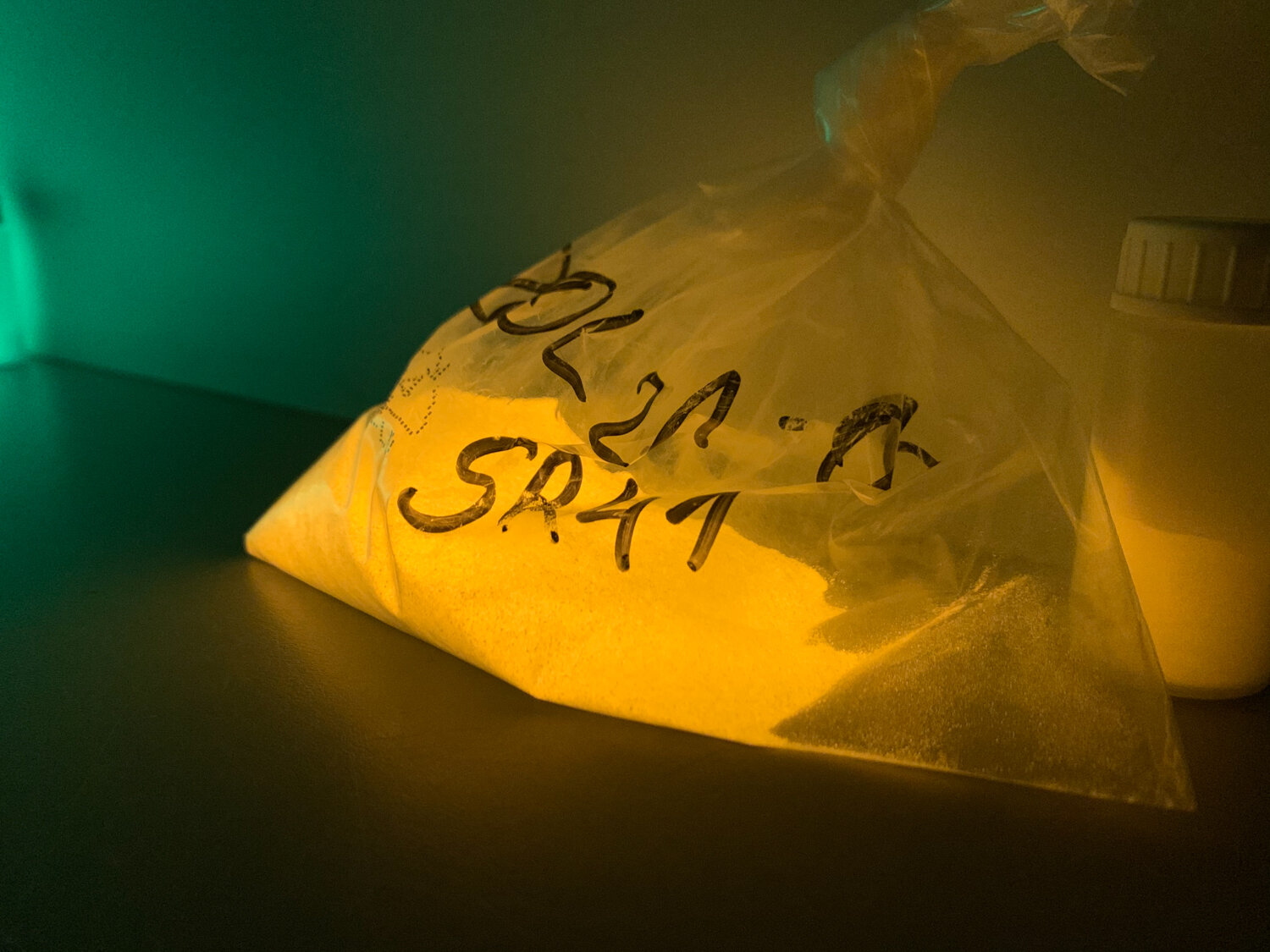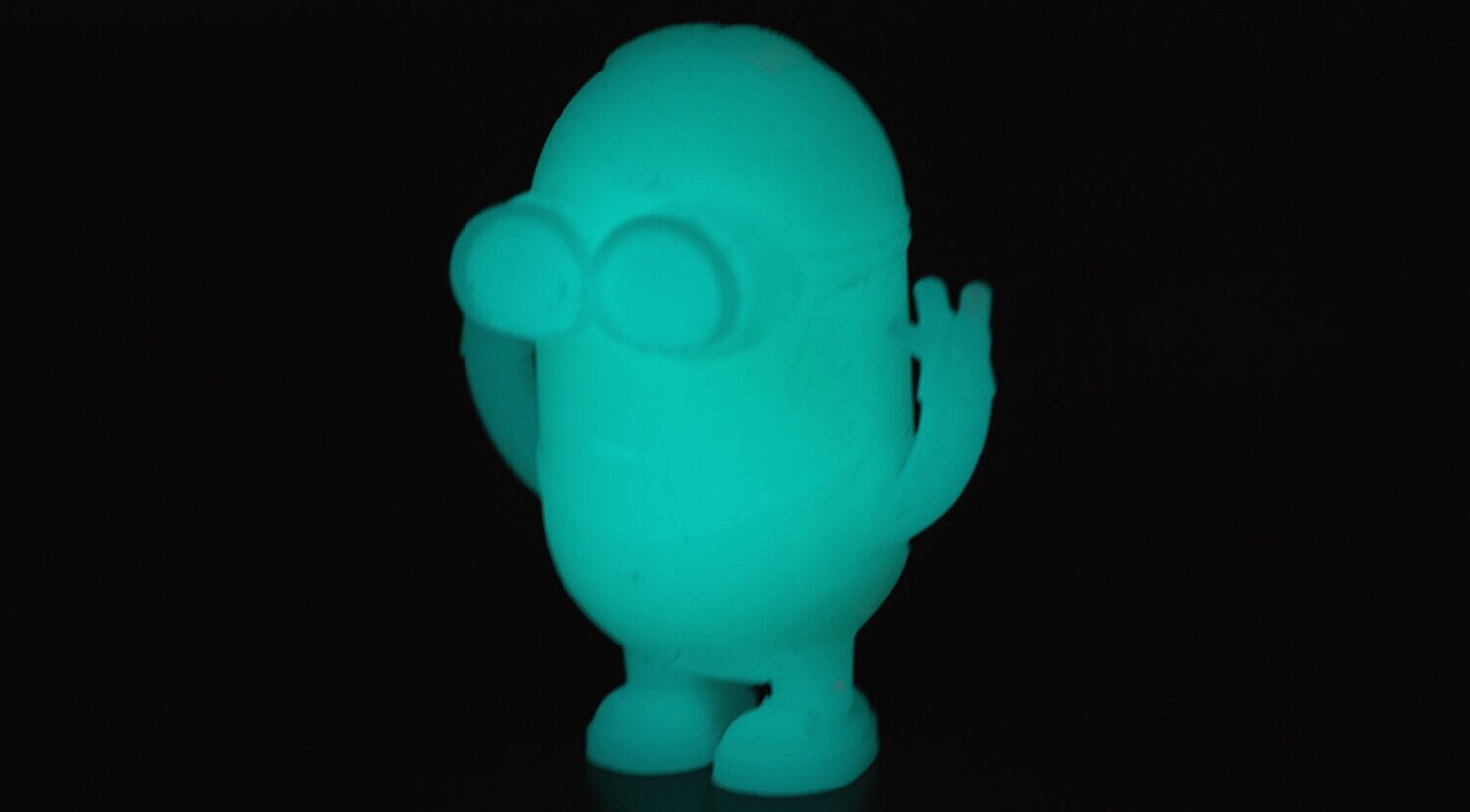What is Swiss Super-LumiNova® ?
Swiss Super-LumiNova® or SLN is a ceramic-based compound that absorbs natural sun and artificial ultraviolet light, projecting luminescence in the dark; it is non-radioactive and harmless. It behaves like a light storage battery, photons are absorbed from the UV-light and with the (newly gained) energy, electrons are lifted into a higher energetic state. It is the energy in the photons that activate the SLN, causing the SLN’s electrons to enter a higher energy state. When these electrons return to their “normal” energy state they emit photons (light) in return. In other words when the ultraviolet light disappears, the absorbed energy is then emitted as visible light over the following hours. This process (charging, storage, emission of light) can be repeated infinite times with SLN and has no age limit.
In the Swiss watch industry, it is used by companies to provide this luminescent property to dials, bezels and hands as well as diverse other components. However, there is no limit to the uses for SLN.
SLN is an aluminate, (in chemistry, an aluminate is a substance containing an oxyanion of aluminium such as AlO2-). It is very hard, in the Mohs hardness rating at 9, diamond being rated at 10. (The Mohs' hardness scale was developed in 1822 by Frederich Mohs. 1 - is the softest until 10 being the hardest). It measures the relative hardness between minerals being able to scratch each other. SLN is non-toxic, non-radioactive.
There exists eight emission colours of Swiss Super-LumiNova®. These are independent of the colours of the SLN viewed in daylight that can be made in virtually any Pantone colour reference.
Examples of some of the Swiss Super-LumiNova powders (viewed in daylight) prior to being added to a bonding agent.
A Brief Recent History
In 1998 LumiNova AG, Switzerland developed a joint-venture with Nemoto & Co. Ltd. Tokyo. In 2007 LumiNova AG, Switzerland starts the licence production of Swiss Super-LumiNova pigments.
An introduction to the process of making Swiss Super-LumiNova presented by Albert Paul Zeller
The graphs below show the effects on SLN from different forms of light.
A simplified view to the process and quality control of Swiss Super-Luminova.
The purified raw materials placed in a crucible prior to being baked at 1500 degrees celcius. The oven used was specifically designed by RC Tritec for the purpose of heating their material. Both the internal environment and the positioning of the crucibles in the oven are specific to the process and kept secret.
After the powdered raw material is placed into the crucible, it is manually compressed and then cut with a blade into squares, as shown here. At this stage the material in non-luminescent and does not absorb for emit light.
When the crucible is removed from the oven after baking the composition has completely changed, both in consistency and luminescent activity. The material has separated into small cubes, it has become luminescent and close to diamond in hardness.
The blocks are a result of the simple cuts that were made in the raw powder material before baking.
At this stage the luminescent properties of the material is fully activated. If one takes a UV-light and shines it at the material, it immediately absorbs the UV energy in seconds, and emits it in darkness.
Grinding the blocks
The next step in the process is to grind the blocks of material into powdered form. This is the most time consuming and delicate phase, and results in the different levels of quality of the final powder. The blocks are close to the same hardness as diamond which results in challenges during this phase. The tools used can potentially pollute the material if too many blocks are attempted to be ground, this in turn would effect the luminescence property of the SLN. In addition, if a block is ground too aggressively into the powdered form, its potency is lost or reduced. Therefore, the blocks are slowly ground and the material constantly sieved so that the resulting powders retain the maximum of the luminescence property.
Below; varying stages of the grinding process. The resulting powders are highly abrasive.
The sieving process
After the material is ground, the powder travels through vibrating sieves separating the different sizes of grain. The process of making SLN is highly labour intensive from beginning to end. During the sieve process the powders are slowly added by hand, in addition to the separation of the different sizes of powder, impurities are removed.
The bags below contain powders with different light emissions. Watches can in essence be made that during the day, their indexes, numbers and hands are all of the same colour due to the pigments added to the Swiss Super-LumiNova, but at night they glow multiple different colours due to the varying light emissions.
Classification and quality control
Once the SLN powder has been produced in its various light emissions it passes through 3 basic quality control criteria that classify the material into over 25 different types of after glow pigment. From the after glow intensity, emission colours, the different grain sizes of the powders, duration of the after glow etc.
The first step is catalogue the physical size of the particles of the SLN, this is done with a Lazer Diffraction Particle Size Analyser. With this machine samples of the powder can be analysed and their sizes associated for different uses.
The second step is to measure the afterglow light intensity of the powders. A sample of SLN powder is placed in the black box and charged for 20 minutes by an ultra-violet light source, then when the light is turned off, a camera system on top of the box measures the length of time and intensity structure that the afterglow emissions follow and last for.
The third step is to measure the afterglow colour of the SLN pigment with a florescence spectrometer.
Final Product
Different clients have different needs. Swiss Super-LumiNova can be made in virtually any Pantone colour with different levels of afterglow efficiency. The darker the pigment that is added to the SLN, the less effective the afterglow. To site two extremes, light green would be strong and dark red would result in a weak afterglow.
The large colour sample has been produced to associated to a specific orange Pantone reference. The second image has had a UV-light shone on the left hand side of the sample to show the green emission colour.
In addition to requests for a SLN product simply by colour reference, clients also send examples of components they want to replicate. Below is an example of a hand that was sent to RC Tritec and one of the comparison cards that was developed whilst the recipe was being developed to match to the colour.
V9 stands for version or trial 9. For new colour references or matches the process can take up to a week of experimentation until the perfect combination of pigments are married together to achieve the desired colour.
Examples of the multiple Pantone references already existing of SLN. The library of recipes constantly developes as clients request new colours.
A sophisticated microscope/measuring apparatus that allows for a three-dimensional digital reproduction of the fine detail on a printed dial to be reproduced. Following which both the contours as well as the depth and shape of the surface printing can be measured and examined. These details are then cross-referenced through multiple tests to be able to analyse the afterglow effectiveness/duration in order to assure the reliability of the final product. Developing an analytical database of all of the different Swiss Super-LumiNova variants produced in different volumes and thicknesses
In the foreground the microscope linked with a computer. The microscope once aligned and focused with the part of the dial it is to measure, automatically moves up and down scanning and measuring the subject.
The lens positioned over the ‘3’. The dial sitting on a precision ground disc with holes to allow the dial feet to pass through.
The resulting 3d scan of the ‘3’. The SLN is printed onto an existing white lacquered ‘3’. This assures the final aesthetic in daylight is sharp and clean.
The cross section of the ‘3’ selected and measured with graph representation below,
The quality control systems combined with the analytical research and experience made by Tritec results in a database of information that allows them to 'prove and validate' their existing technologies and advance and develop new products.
When the new SLN products are developed for hands, they are also applied to sample hands in order to validate the powders and binding agents before being sent to the client.
The tip of the tool to be added to the pen used to apply the mixed SLN compounds to the hands.
Examples of the hands with the SLN applied. Once the SLN is dry a final lacquer is added to the underside of the hand to seal the mixture and assure the correct colour and reflection.
A rotor for a watch made by ‘Vault’ watch brand specifically to incorporate Swiss Super-Lumi-Nova.
The SLN is added using a pneumatic pen with fine nib.
The image shows the first spots of SLN in place and directly after being charged by a UV-Light source.
Future developments.
The use of luminescent compounds is endless, from babies dummies that glow at night to be easily found, through to glowing escape handles in the boots of cars. The use of luminescent compounds has also been incorporated into thread used on boats and well as designer training shoes.
Summary
Above and below are examples of trials using new luminescent materials and 3D printers. The beauty of the material is found in its functionality, longevity and diversity of use. RC Tritec have taken a material concept and over years of R&D developed and refined it so that it can be used in multiple industries, in a plethora of ways, backed up by constant analysis and creativity.
To learn more about RC Tritec

































